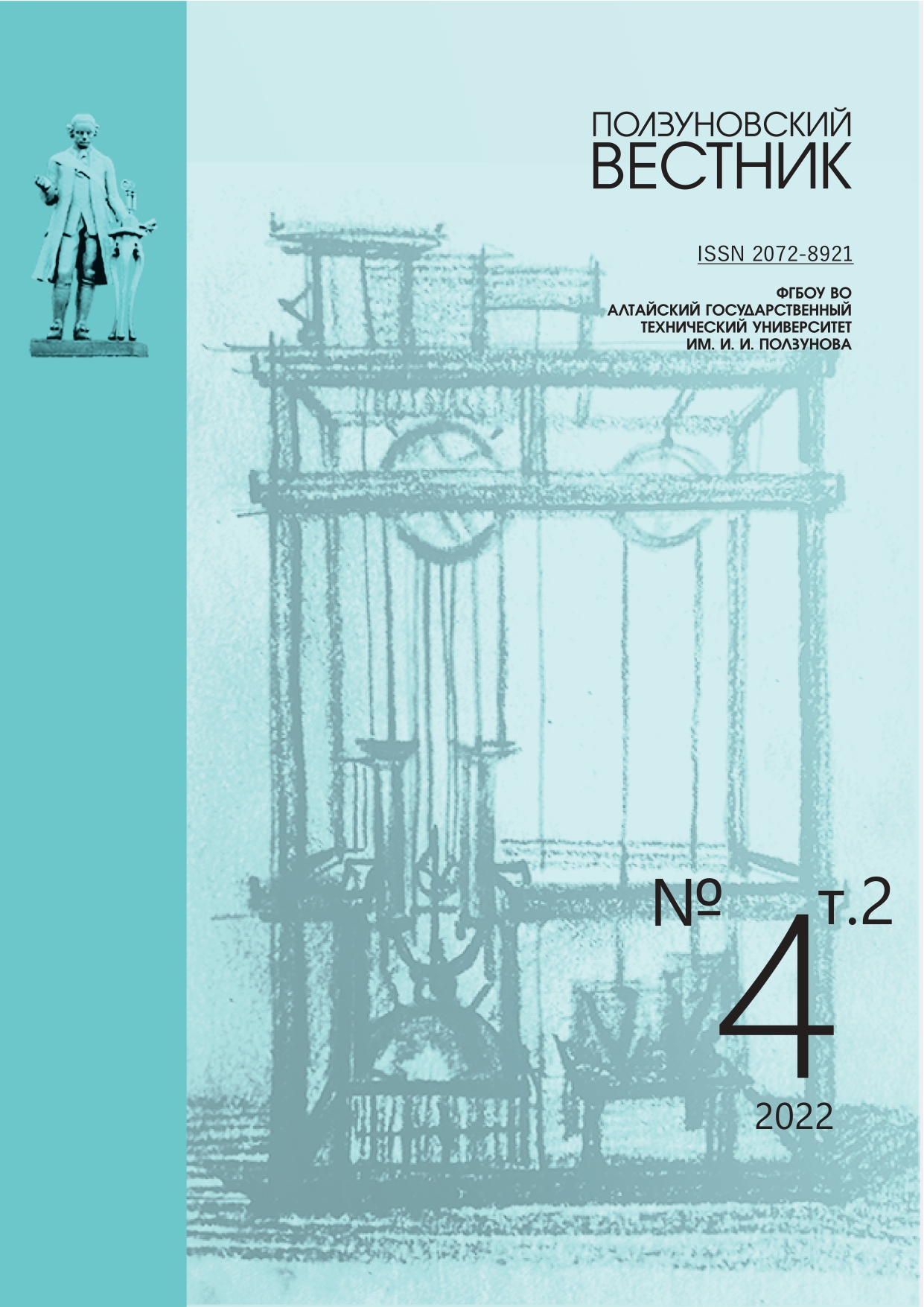Influence of heat treatment on alloys of the Al-Mg-Si system with an excess of silicon and small zirconium additives
ZFEZAM
DOI:
https://doi.org/10.25712/ASTU.2072-8921.2022.4.2.021Keywords:
Aluminum alloys, small zirconium additives, multistage heat treatment, C-curves, scanning electron microscopy, intermetallics.Abstract
The study is aimed at studying heat treatment for the formation of physical and mechanical properties in the Al-Mg-Si system with an excess of silicon and small zirconium additives. The study was carried out on the example of three alloys with different Mg/Si ratios with a zirconium content of 0.15%. The alloys were subjected to both one and two-stage heat treatment. In the course of a single-stage heat treatment, the alloys were annealed at a temperature of 375–550 °C and holding, which ranged from 10 seconds to 100 hours, followed by fixation of the microstructure in water. In addition, a multi-stage heat treatment was carried out, the annealing temperature of the first stage was varied in the range of 425–550 °C with an 8-hour exposure and subsequent fixation in water, after which the metal was subjected to a 3-hour artificial aging. After completion of the heat treatment, the microhardness and electrical conductivity were investigated. Based on the data on the change in the latter depending on the mode of heat treatment, C-curves of the decomposition of the supersaturated solid solution were constructed.
For some modes of heat treatment, studies of intermetallic particles were carried out using scanning microscopy. Using scanning electron microscopy, particles were found in the alloys, similar in their chemical composition to Mg2Si, Al3(FeSi) and Zr2Si.
The obtained C-curves show that the decomposition of a supersaturated solid solution begins already at a temperature of 375 °C. Using the constructed C-curves, the influence of the content of silicon, magnesium elements on the rate of decomposition of a supersaturated solid solution is shown.
It has been established that the annealing temperature of 375 and 425°C adversely affects the microhardness in the alloys under consideration. After an increase in the annealing temperature to 550°C, there is practically no decrease in microhardness.
The performed studies made it possible to choose the optimal mode of multi-stage heat treatment, namely heating to 550 °C for 8 hours with cooling in water, and subsequent 3-hour exposure at a temperature of 180 °C. In general, zirconium additives give an increase in microhardness by 11-25 HV compared to base alloys.
References
Sizyakov V.M., Bazhin V.Y., Vlasov A.A. Status and Prospects for Growth of the Aluminum Industry. Metallurgist 2010, 54, 409-414.
I. Polmear (2005), Light Alloys (Fourth Edition), Oxford, England.
Meyruey G. et al. Over-ageing of an Al-Mg-Si alloy with silicon excess //Materials Science and Engineering: A. – 2018. – Т. 730. – С. 92-105.
Колачев Б. А., Елагин В. И., Ливанов В. А. Металловедение и термическая обработка цветных металлов и сплавов. – МИСиС, 2005.
Matsuda K. et al. Comparison of precipitates between excess Si-type and balanced-type Al-Mg-Si alloys during continuous heating //Metallurgical and materials transactions A. – 2005. – Т. 36. – №. 8. – С. 2007-2012.
Developing an Optimized Homogenization Process for Sc and Zr Containing Al-Mg-Si Alloys / S. Babaniaris, M. Ramajayam, Lu Jiang, T. Langan, T. Dorin // Light Metals. 2019.
Aryshenskii, Evgeniy V., et al. “Features of the Microstructural Composition of Low-Alloyed Aluminum Alloys of the 6XXX Series with Small Additions of Zr and Sc.” Key Engineering Materials, vol. 910, Trans Tech Publications, Ltd., 15 Feb. 2022, pp. 994–1001. Crossref, doi:10.4028/p-r1o05m.
Влияние дополнительного легирования скандием и скандием с цирконием на прочностные свойства сплавов системы Al-Mg-2Si / Л.Л. Рохлин, Н.Р. Бочвар, Н.П. Леонова, А.В. Суханов. // Заводская лаборатория. Диагностика материалов. 2015. № 5.
Магаюмова О.Н., Лоозе В.В., Минеева Н.С. Цирконий - минерально-сырьевая база мирового и российского рынков // Инновационные технологии производства и хранения материальных ценностей для государственных нужд. 2021. №15.
Multi-alloying effect of Sc, Zr, Cr on the Al-Mg-Si-Mn high-pressure die casting alloys / O.Pracha, O.Trudonoshynbc, P.Randelzhoferb, С.Körnerb, K.Durst // Materials Characterization. 2020. № 168. https://doi.org/10.1016/j.matchar.2020.110537
Рохлин Л. Л., Бочвар Н. Р., Леонова Н. П. Исследование распада пересыщенного твердого раствора в сплавах Al - Sc - Zr при различном соотношении скандия и циркония // Перспективные материалы. 2011. №3.
Wuhua Yuan, Zhenyu Liang. Effect of Zr addition on properties of Al–Mg–Si aluminum alloy used for all aluminum alloy conductor // Materials and Design. 2011. №8-9
Effect of Zr addition on properties of Al–Mg–Si aluminum alloy used for all aluminum alloy conductor Wuhua Yuan, Zhenyu Liang.
Enhanced aging precipitation behavior and mechanical properties of 6022 Al–Mg–Si alloy with Zr addition Ming-Xue Zhang, Cheng Wang, Shao-You Zhang a, Xu Liu a, Xuan Wang, Ming-Wen Ren, Hui-Yuan Wang.
Influence of Zr addition on precipitation evolution and performance of Al-Mg-Si alloy conductor Jiani Fu, Zhao Yang⁎, Yunlai Deng, Yefeng Wu, Jianqi Lu.
Developing an Optimized Homogenization Process for Sc and Zr Containing Al-Mg-Si Alloys Steven Babaniaris, Mahendra Ramajayam, Lu Jiang, Timothy Langan, and Thomas Dorin.
В.В. Захаров Устойчивость твердого раствора скандия в алюминии, Цветные металлы и сплавы, «Металловедение и термическая обработка металлов», №2, стр. 15, 1997.
Aryshenskii, E., Lapshov, M., Hirsch, J., Konovalov, S., Bazhenov, V., Drits, A., & Zaitsev, D. (2021). Influence of the small sc and zr additions on the as-cast microstructure of al–mg–si alloys with excess silicon. Metals, 11(11), 1797.
Downloads
Published
How to Cite
Issue
Section
License
Copyright (c) 2022 Evgeniy V. Arishenskiy, Maksim A. Lapshov, Mikhail V. Solopayev, SergeyV. Konovalov

This work is licensed under a Creative Commons Attribution 4.0 International License.















 .
. This work is licensed under a
This work is licensed under a 
